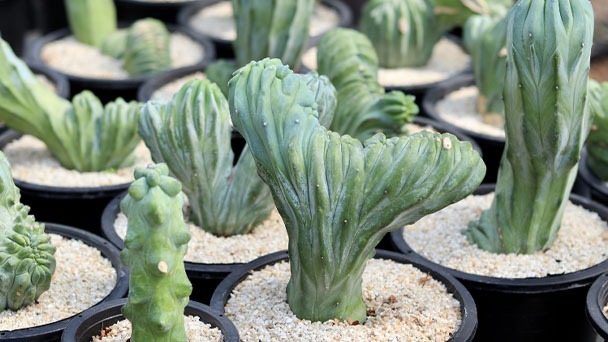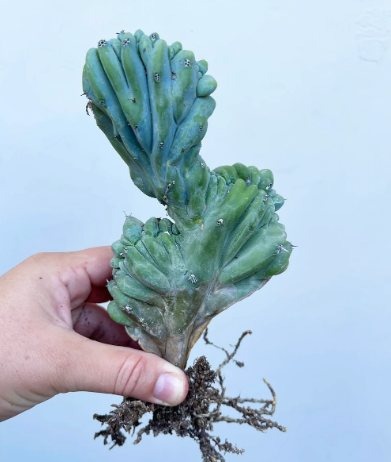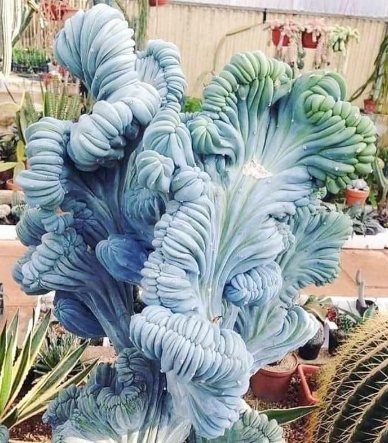Blue Smoke Cactus - How to Plant & How Fast Does Them Grow
Written by Ivy
Jan 06 2023

Your indoor or outdoor garden will look lovely with a Blue Smoke Cactus. Primarily the northern and central regions of Mexico are home to the plant. The blue smoke cactus, also known as Myrtillocactus Geometrizan, has unusual foliage and thick fleshy stems that can enhance the appearance of your garden. Beautiful purple-blue flowers are produced by the plant, and you may also see purple fruits, also known as bilberries.
What you should know about the development and maintenance of blue cacti. Although blue cacti grow slowly, they can grow to a height of up to 6 feet. They are spine-covered and have thick, fleshy stems. The flowers typically bloom in the spring and are blue or purple.
Quick Information About Blue Smoke Cactus
- Common Names: Blue Smoke Cactus, Blue Crest, Crested Blue Candle
- Scientific Name: Myrtillocactus Geometrizan
- Native Place: Central and Northern Mexico
- Family: Cactaceae
- Genus: Myrtillocactus
- Mature Size: 13 feet to 16 feet
- Flower Color: Purple-blue
- Hardiness Zone: USDA zones 9a to 11b
- Propagation Method: Stem Cuttings
- Bloom Period: Springs and Summers
- Toxicity: Mildly Toxic
- Best Suited: Indoors/Outdoors
What is Blue Smoke Cactus

A blue smoke cactus can be recognized by its appearance, which resembles a pair of breasts. The swollen tubercles on this unusual cactus, which resemble human breasts, are what give it its name. Also known as the breast cactus.
The Sonoran Desert in Mexico is home to the blue smoke cactus. It is a cactus that grows slowly and has a maximum height of 16 feet. The springtime is when the blue smoke cactus blooms, and its flowers are an exquisite purple-blue hue.
If you're fortunate enough to own a blue smoke cactus, you'll need to take good care of it so it can thrive. These cacti require full sun and well-drained soil. You won't have to water them all the time because they can tolerate droughts to some extent. Just be sure to give them a good soak every so often.
Your blue smoke cactus will be a lovely and distinctive addition to your home if you take good care of it.
How to Grow a Blue Smoke Cactus
Blue smoke is simple to propagate, just like other succulents. In just a few weeks, a leaf or branch from somewhere else can develop into your own plant. Remove a stem with a clean, sharp knife or pair of scissors, and let it sit for a few days so that a callus forms. It should be planted in a soil that drains well, and once the soil has completely dried out, water it. Keep in mind that cuttings can only take root in warm or hot weather.
This step-by-step manual by House & Garden Care explains how to use seeds and suggests planting during the warm months. To begin, clean a ripe fruit and allow it to fully dry. After that, you can plant the seeds. This plant will develop as it should if it receives the right amount of water and light. It also doesn't really require pruning.
How to Care for Blue Smoke Cactus?
The blue smoke cactus is an attractive cactus that doesn't need much care from the owner. The best conditions must be offered to the various varieties of cacti in order for them to bloom. Whether to plant it inside or outside will depend on the climate, plant's size, season, and age. Here's how to grow your plant as quickly and healthily as possible.
- Soil: Sandy soil with good drainage is preferred by the blue smoke cactus. By combining cactus and succulent soil blend with some gravel, you can create the ideal soil mix for your cactus. To ensure proper drainage and enough airflow, add some pebbles to the bottom. By placing gravel around the plant, you can give your cactus its natural rocky habitat.
- Water: Since these plants can withstand droughts, you should only water them when the soil feels dry to the touch. Give the plant a thorough soak when you water it to ensure that the water gets all the way to the roots. You must ensure that the soil is entirely dry before you apply any further watering. For long periods of water to sit at the roots, you need good drainage at the bottom. To achieve this, add gravel to the bottom of the container, soak the soil, and let it air dry before watering. Apply the same method when watering your cactus.
- Light: Although it does well in partial shade as well, the blue smoke cactus prefers full sun. Keep the plant in light shade or partial shade when it is young. When the plant is mature, you can move it to full sun shade outside. Choose a south window location so your plant receives direct sunlight if you plan to keep it indoors.
- Temperature: If you live somewhere with a hot climate, give your plant some afternoon shade. Keep your plant inside if you live somewhere cold because it cannot withstand temperatures below -4 degrees Celsius. These species do well in warm climates, but if you are from a colder region, you will need to take a little more care.
- Fertilizer: Once a month during the growing season, fertilize your blue smoke cactus plant for consistent growth. However, you can fertilize the cactus twice a month with a high-phosphorous cactus fertilizer to promote the blooms. It is advised to fertilize the plant in the spring and summer when it is blooming. Never over-fertilize your cactus for healthy growth since the plant doesn't entirely rely on fertilizers.
Blue Smoke Cactus Varieties
When it comes to the blue smoke cactus, there are many different varieties, each with its own special traits and gorgeous combinations. Here are some of the major varieties:
- Breast Cactus: The Breast Cactus, also called Fukurokuryuzinboku in Japan, is a rare species with swollen tissues that resemble human breasts. It is also frequently called a booby cactus or a titty cactus.
- Blue Candle Crest Cactus: The blue candle crest cactus, also known by its scientific name of Myrtillocactus geometrizans, is a well-liked variant of the blue smoke cactus species. The plant typically yields palatable fruits and is also employed in medicine to reduce inflammation.

Health Benefits and Risks
- The Blue Smoke Cactus is moderately poisonous to both humans and animals. When consumed raw by animals, it can cause digestive issues because it contains mescaline, one of the strongest hallucinogens on the planet.
- Since its thorns can also cause mouth and throat injuries, the blue crest cactus plant must be kept away from children and animals.
- Blue smoke cacti produce delicious bilberries as their fruit. In addition to ice cream, liqueurs, jam, and even jelly, bilberries are used to make these products.
- The fruits of the blue smoke cactus are also high in antioxidants, fibre, and Vitamin C.
Although the origin of blue cactus plants is unknown, we do know that the color is unusual in the natural world. Although it is small, the Fukurokuryuzinboku (breast cactus) looks nice on a shelf or table if you want an indoor plant. In a garden or outdoor space, plants can be separated from one another and positioned out of the way of onlookers. By doing this, it will be simpler to recognize them in all of their beauty as they develop and spread. If you want to buy a blue smoke cactus for yourself, you can do so online or by visiting the local nursery. In order for your blue smoke cactus to thrive, you'll need to take good care of it if you're fortunate enough to own one.
Is the Blue Smoke Cactus Toxic?
Animals and humans are both moderately toxic to blue smoke. It contains mescaline, one of the strongest hallucinogens on earth, and when consumed raw, it can harm a pet's digestive system (source: Garden Beast). The raw plant must be kept far away from children and animals because its thorns can also cause throat and mouth injuries. Due to its size and shape, it should be positioned in a location where it will not obstruct traffic.
Blue smoke cacti do, however, produce edible fruit! Because of their flavor and health advantages, bilberries are frequently sold in Mexico as garambullos. The plant is spread across a number of places, including Baja California, the State of Mexico, Durango, Guanajuato, Michoacán, and many others. Bilberries are used to create ice cream, liqueurs, drinks, jam, and jelly. They have a reputation for being a good source of antioxidants, fiber, and vitamin C.
How to Repot a Blue Smoke Cactus
Expect to repot the blue smoke every one to two years due to its size and rapid growth. Repotting the plant might also be beneficial if it has been damaged by excessive watering. Early spring is the ideal time to carry out this task because that is when they emerge from their dormant state, according to Tula. Otherwise, whenever they outgrow their pot, the summer months are good for repotting as well. Because too much soil can prevent the roots and stems from growing properly, Plantophiles advises placing blue smoke cactus in a smaller container as opposed to a larger one. Moreover, they are adamant about using fresh fertilizer and soil.
Always inspect the roots for damage and get rid of any that are frail. Following repotting, don't water. The transition to the new pot will be simpler once the blue smoke cactus is dry, so give it about a week to get used to it. Clay, ceramic, and terracotta are the best materials to use when creating pots.
Where Does Blue Smoke Cactus Grow?
Beautiful plant species native to central and northern Mexico include the blue smoke cactus (Myrtillocactus geometrizans). It is a versatile plant for any home because it can grow both inside and outside. The blue-gray hue that frequently emanates from the cactus is where it gets its name.
How Fast Does Blue Cactus Grow?
You might be curious about how quickly blue cacti grow if you're considering including one in your desert landscape. The fastest-growing cacti are not blue cacti; their annual growth rate can reach 1 1/2 feet. They can survive in a variety of environments, though, and are comparatively simple to care for.
Frequently Asked Questions
How Often You Must Water Your Blue Smoke Cactus Plant?
Water them once every two weeks in the summer and once a month in the winter.
What is the Best Time to Propagate the Blue Smoke Cactus Plant?
The summer months, when the plant is in a growing stage, are the best times to propagate.
When Do You Repot Your Blue Smoke Cactus and What is the Best Time to Do So?
Every one to two years, you should repot your blue cactus, and the best time to do it is right after the plant emerges from its dormant period in the early spring.
Conclusion
Place your plant close to a south-facing window if you reside in a cold climate to give it the most light possible. Provide your plant with some afternoon shade if you live in a hot climate. Sandy, well-drained soil is preferred by the blue smoke cactus.
Latest Updated
- Benefits of Bugleweed - 7 Science-backed Health Benefits
- Bugleweed Dangers & Side Effects - Is It Poisonous?
- How to Plant Evergreen Trees - What You Should Know
- When to Plant Evergreens - Grow Guide for Evergreen Trees
- 12 Wonderful Evergreen Shrubs for Your Garden
- 12 Popular Evergreen Plants with Pictures for Beginners
- When And How To Prune A Lilac Bush Like a Pro
- How to Grow & Care for Lilac Vine (Hardenbergia Violacea)
- Japanese Lilac Tree (Syringa Reticulata) Care & Propagation Guide
- Shumard Oak Pros and Cons - What to Know
Popular Articles
- Winter maintenance of Antirrhinum Majus
- How to Grow Terminalia Mantaly Tree
- How to Grow and Care for Crossostephium Chinense
- How to grow Antirrhinum Majus in spring
- Peristeria Elata (Dove Orchid) Profile: Info & Care Guide
- Underwatered Snake Plant (Sansevieria Trifasciata) - Signs And How To Fix
- How to Care for Brazilian Jasmine Plant (Mandevilla Sanderi)
- How to Grow & Care for Graptopetalum Purple Delight in Summer
- Rosa Chinensis (China Rose): Plant Growing & Care Tips
- How to Care for Baby Sun Rose (Aptenia Cordifolia)